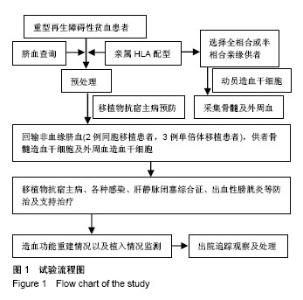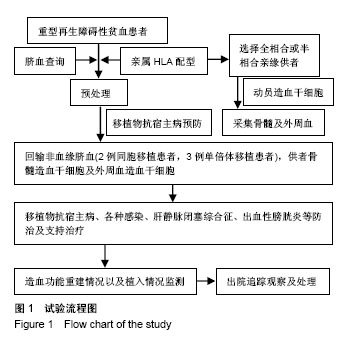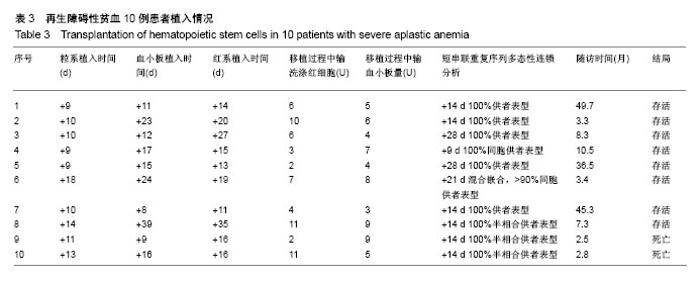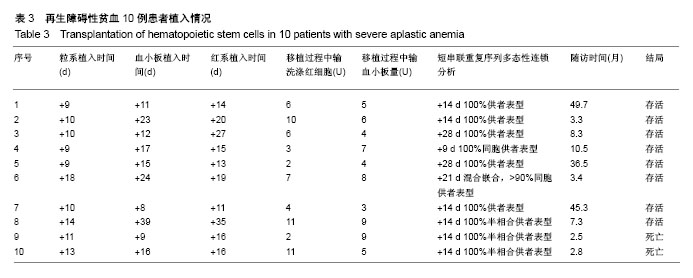Chinese Journal of Tissue Engineering Research ›› 2019, Vol. 23 ›› Issue (13): 2042-2048.doi: 10.3969/j.issn.2095-4344.1686
Previous Articles Next Articles
Allogeneic hematopoietic stem cell transplantation for severe aplastic anemia in 10 cases
Wei Yuanfeng, Wei Zhongling, Yang Yuqiong, Qi Jing, Yan Jiawei, Huang Dongping
- Department of Hematology, Yijishan Hospital, Wannan Medical College, Wuhu 241000, Anhui Province, China
-
Revised:2019-01-16Online:2019-05-08Published:2019-05-08 -
Contact:Huang Dongping, Chief physician, Master’s supervisor, Department of Hematology, Yijishan Hospital, Wannan Medical College, Wuhu 241000, Anhui Province, China -
About author:Wei Yuanfeng, Master candidate, Department of Hematology, Yijishan Hospital, Wannan Medical College, Wuhu 241000, Anhui Province, China. Wei Zhongling, Master, Associate chief physician, Department of Hematology, Yijishan Hospital, Wannan Medical College, Wuhu 241000, Anhui Province, China. Wei Yuanfeng and Wei Zhongling contributed equally to this work. -
Supported by:the Natural Science Foundation of Anhui Provincial Education Department, No. KJ2016SD58 (to HDP); the Key Scientific Research Project of Wannan Medical College, No. WK2018ZF09 (to WZL)
CLC Number:
Cite this article
Wei Yuanfeng, Wei Zhongling, Yang Yuqiong, Qi Jing, Yan Jiawei, Huang Dongping. Allogeneic hematopoietic stem cell transplantation for severe aplastic anemia in 10 cases[J]. Chinese Journal of Tissue Engineering Research, 2019, 23(13): 2042-2048.
share this article
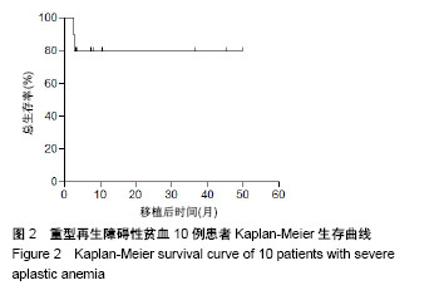
2.4 并发症 2.4.1 移植物抗宿主病 共有4例发生急性移植物抗宿主病,中位发生时间为移植后26.5(13-120) d,其中Ⅱ度急性移植物抗宿主病2例,Ⅳ度急性移植物抗宿主病2例。发生Ⅳ度急性移植物抗宿主病的患者均为单倍体相合异基因造血干细胞移植。截止到随访日期,无患者发生慢性移植物抗宿主病。 2.4.2 感染 上呼吸道感染3例;肺部感染6例,其中2例系肺部细菌、真菌混合性感染(例8、例9);败血症4例,致病菌为大肠埃希菌2例、肺炎克雷伯菌2例;尿路感染3例;肛周软组织感染1例;皮肤软组织感染1例;巨细胞病毒血症9例;EB病毒血症6例,其中2例(例4、例8)同时伴有浅表淋巴结及肝脾肿大,临床疑诊为EB病毒相关淋巴组织增殖性疾病(EBV-PTLD),给予利妥昔单抗375 mg/(m2•周),2-4次治疗后EB病毒转阴。 2.4.3 其他并发症 10例患者中出血性膀胱炎3例,其中同胞全合异基因造血干细胞移植组1例,单倍体相合异基因造血干细胞移植组2例,予以水化、碱化、强迫利尿等治疗后痊愈;亚甲炎1例;甲减1例。所有患者移植过程中均未发生肝静脉闭塞综合征以及血清病。 2.4.4 移植相关死亡 例9移植后并发胰腺功能损害及心功能不全,在积极对症处理后症状好转;移植后24 d并发肺部混合性感染,移植后27 d患者并发Ⅳ度急性移植物抗宿主病;经过积极抗感染、甲强龙、他克莫司、间充质干细胞输注、CD25单抗等治疗,症状有所控制,之后因患者坚决放弃治疗,于移植后79 d死亡。例10患者移植后并发肺部感染、血栓性微血管病,家属放弃治疗,于移植后85 d死亡。 2.5 疗效及随访 10例患者全部获得稳定植入及造血重建。中位随访时间7.3(2.5-49.7)个月,同胞全合异基因造血干细胞移植组7例患者全部存活,3例进行单倍体相合异基因造血干细胞移植患者1例存活,总的生存率为80%,见图2。"
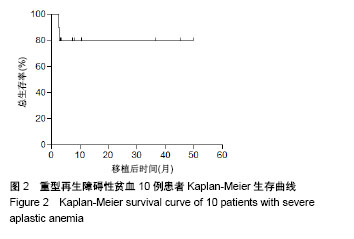
| [1] 张然,夏凌辉.重型再生障碍性贫血的移植治疗[J].临床内科杂志, 2017,34(12):803-806. [2] Bacigalupo A, Brand R, Oneto R, et al. Treatment of acquired severe aplastic anemia: bone marrow transplantation compared with immunosuppressive therapy--The European Group for Blood and Marrow Transplantation experience. Semin Hematol. 2000;37(1):69-80.[3] 付蓉. 再生障碍性贫血诊断与治疗中国专家共识(2017年版)[J]. 中华血液学杂志, 2017,38(1):1-5.[4] Bacigalupo A. How I treat acquired aplastic anemia. Blood. 2017;129(11):1428-1436.[5] Killick SB, Bown N, Cavenagh J, et al. Guidelines for the diagnosis and management of adult aplastic anaemia. Br J Haematol. 2016;172(2):187-207.[6] Gupta V, Eapen M, Brazauskas R, et al. Impact of age on outcomes after bone marrow transplantation for acquired aplastic anemia using HLA-matched sibling donors. Haematologica. 2010;95(12):2119-2125.[7] Sangiolo D, Storb R, Deeg HJ, et al. Outcome of allogeneic hematopoietic cell transplantation from HLA-identical siblings for severe aplastic anemia in patients over 40 years of age. Biol Blood Marrow Transplant. 2010;16(10):1411-1418.[8] Shibuya A, Ishii S, Obinata K. Successful bone marrow plus cord blood stem cell transplantation in a girl who developed myelodysplastic syndrome from hepatitis-associated aplastic anemia treated with long-term immunosuppressants and growth factors. Hematology. 2002;7(5):301-304.[9] Fernández MN. Improving the outcome of cord blood transplantation: use of mobilized HSC and other cells from third party donors. Br J Haematol. 2009;147(2):161-176.[10] Sánchez-Ortega I, Arnan M, Patiño B, et al. Early engraftment and full-donor chimerism after single-cord blood plus third-party donor dual transplantation in patients with high-risk acute leukemia. Bone Marrow Transplant. 2014;49(1): 145-147.[11] van Besien K, Hari P, Zhang MJ, et al. Reduced intensity haplo plus single cord transplant compared to double cord transplant: improved engraftment and graft-versus-host disease-free, relapse-free survival. Haematologica. 2016; 101(5):634-643.[12] Yamei W, Rongmu L, Yongbin C, et al. Improved outcome of haploidentical transplantation in severe aplastic anemia using reduced-intensity fludarabine-based conditioning. Oncotarget. 2017;8(48):83817-83830.[13] Xu L, Liu Z, Wu Y, et al. Clinical evaluation of haploidentical hematopoietic combined with human umbilical cord-derived mesenchymal stem cells in severe aplastic anemia. Eur J Med Res. 2018;23(1):12.[14] 郭智,陈惠仁,刘晓东,等. 低强度预处理联合移植后诱导免疫耐受的单倍体相合Allo-HSCT治疗重型再生障碍性贫血的临床疗效研究[J].中国实验血液学杂志,2016,24(6):1811-1816.[15] Xu LP, Jin S, Wang SQ, et al. Upfront haploidentical transplant for acquired severe aplastic anemia: registry-based comparison with matched related transplant. J Hematol Oncol. 2017;10(1):25.[16] Im HJ, Koh KN, Choi ES, et al. Excellent outcome of haploidentical hematopoietic stem cell transplantation in children and adolescents with acquired severe aplastic anemia. Biol Blood Marrow Transplant. 2013;19(5):754-759.[17] Penack O, Tridello G, Hoek J, et al. Influence of pre-existing invasive aspergillosis on allo-HSCT outcome: a retrospective EBMT analysis by the Infectious Diseases and Acute Leukemia Working Parties. Bone Marrow Transplant. 2016; 51(3):418-423.[18] Maury S, Bacigalupo A, Anderlini P, et al. Improved outcome of patients older than 30 years receiving HLA-identical sibling hematopoietic stem cell transplantation for severe acquired aplastic anemia using fludarabine-based conditioning: a comparison with conventional conditioning regimen. Haematologica. 2009;94(9):1312-1315.[19] 吴祥元.外周血干细胞移植的临床应用[J].实用医学杂志, 2000, 16(1):8.[20] 胡亮钉,陈虎,江岷,等.异基因外周血造血干细胞移植治疗骨髓增生异常综合征23例疗效分析[J].中华血液学杂志, 2006,27(8): 522-524.[21] Schrezenmeier H, Passweg JR, Marsh JC, et al. Worse outcome and more chronic GVHD with peripheral blood progenitor cells than bone marrow in HLA-matched sibling donor transplants for young patients with severe acquired aplastic anemia. Blood. 2007;110(4):1397-1400.[22] Bacigalupo A, Socié G, Schrezenmeier H, et al. Bone marrow versus peripheral blood as the stem cell source for sibling transplants in acquired aplastic anemia: survival advantage for bone marrow in all age groups. Haematologica. 2012; 97(8):1142-1148.[23] 黄晓军,陈育红,许兰平,等. G-CSF动员的骨髓及外周血干细胞移植治疗重型再生障碍性贫血[J]. 基础医学与临床, 2004, 24(3):54-57.[24] 刘会兰,孙自敏,耿良权,等.G-CSF动员后异基因骨髓联合外周血干细胞移植治疗血液病[J].临床内科杂志,2008,25(6):374-376.[25] Ali AS, Al-Shraim M, Al-Hakami AM, et al. Epstein- Barr Virus: Clinical and Epidemiological Revisits and Genetic Basis of Oncogenesis. Open Virol J. 2015;9:7-28.[26] 刘丽,冯四洲.异基因造血干细胞移植后EB病毒相关淋巴增殖性疾病研究进展[J].中华血液学杂志,2017,38(9):817-821.[27] 韩婷婷,许兰平,刘代红,等.异基因造血干细胞移植后EB病毒感染情况分析[J]. 中华血液学杂志, 2013, 34(8): 651-654.[28] Styczynski J, van der Velden W, Fox CP, et al. Management of Epstein-Barr Virus infections and post-transplant lymphoproliferative disorders in patients after allogeneic hematopoietic stem cell transplantation: Sixth European Conference on Infections in Leukemia (ECIL-6) guidelines. Haematologica. 2016;101(7):803-811.[29] Morscio J, Tousseyn T. Recent insights in the pathogenesis of post-transplantation lymphoproliferative disorders. World J Transplant. 2016;6(3):505-516.[30] Patriarca F, Medeot M, Isola M, et al. Prognostic factors and outcome of Epstein-Barr virus DNAemia in high-risk recipients of allogeneic stem cell transplantation treated with preemptive rituximab. Transpl Infect Dis. 2013;15(3):259-267.[31] Kobayashi S, Sano H, Mochizuki K, et al. Pre-emptive rituximab for Epstein-Barr virus reactivation after haplo-hematopoietic stem cell transplantation. Pediatr Int. 2017;59(9):973-978. |
| [1] | Zhang Tongtong, Wang Zhonghua, Wen Jie, Song Yuxin, Liu Lin. Application of three-dimensional printing model in surgical resection and reconstruction of cervical tumor [J]. Chinese Journal of Tissue Engineering Research, 2021, 25(9): 1335-1339. |
| [2] | Zeng Yanhua, Hao Yanlei. In vitro culture and purification of Schwann cells: a systematic review [J]. Chinese Journal of Tissue Engineering Research, 2021, 25(7): 1135-1141. |
| [3] | Xu Dongzi, Zhang Ting, Ouyang Zhaolian. The global competitive situation of cardiac tissue engineering based on patent analysis [J]. Chinese Journal of Tissue Engineering Research, 2021, 25(5): 807-812. |
| [4] | Wu Zijian, Hu Zhaoduan, Xie Youqiong, Wang Feng, Li Jia, Li Bocun, Cai Guowei, Peng Rui. Three-dimensional printing technology and bone tissue engineering research: literature metrology and visual analysis of research hotspots [J]. Chinese Journal of Tissue Engineering Research, 2021, 25(4): 564-569. |
| [5] | Chang Wenliao, Zhao Jie, Sun Xiaoliang, Wang Kun, Wu Guofeng, Zhou Jian, Li Shuxiang, Sun Han. Material selection, theoretical design and biomimetic function of artificial periosteum [J]. Chinese Journal of Tissue Engineering Research, 2021, 25(4): 600-606. |
| [6] | Liu Fei, Cui Yutao, Liu He. Advantages and problems of local antibiotic delivery system in the treatment of osteomyelitis [J]. Chinese Journal of Tissue Engineering Research, 2021, 25(4): 614-620. |
| [7] | Li Xiaozhuang, Duan Hao, Wang Weizhou, Tang Zhihong, Wang Yanghao, He Fei. Application of bone tissue engineering materials in the treatment of bone defect diseases in vivo [J]. Chinese Journal of Tissue Engineering Research, 2021, 25(4): 626-631. |
| [8] | Zhang Zhenkun, Li Zhe, Li Ya, Wang Yingying, Wang Yaping, Zhou Xinkui, Ma Shanshan, Guan Fangxia. Application of alginate based hydrogels/dressings in wound healing: sustained, dynamic and sequential release [J]. Chinese Journal of Tissue Engineering Research, 2021, 25(4): 638-643. |
| [9] | Chen Jiana, Qiu Yanling, Nie Minhai, Liu Xuqian. Tissue engineering scaffolds in repairing oral and maxillofacial soft tissue defects [J]. Chinese Journal of Tissue Engineering Research, 2021, 25(4): 644-650. |
| [10] | Xing Hao, Zhang Yonghong, Wang Dong. Advantages and disadvantages of repairing large-segment bone defect [J]. Chinese Journal of Tissue Engineering Research, 2021, 25(3): 426-430. |
| [11] | Chen Siqi, Xian Debin, Xu Rongsheng, Qin Zhongjie, Zhang Lei, Xia Delin. Effects of bone marrow mesenchymal stem cells and human umbilical vein endothelial cells combined with hydroxyapatite-tricalcium phosphate scaffolds on early angiogenesis in skull defect repair in rats [J]. Chinese Journal of Tissue Engineering Research, 2021, 25(22): 3458-3465. |
| [12] | Wang Hao, Chen Mingxue, Li Junkang, Luo Xujiang, Peng Liqing, Li Huo, Huang Bo, Tian Guangzhao, Liu Shuyun, Sui Xiang, Huang Jingxiang, Guo Quanyi, Lu Xiaobo. Decellularized porcine skin matrix for tissue-engineered meniscus scaffold [J]. Chinese Journal of Tissue Engineering Research, 2021, 25(22): 3473-3478. |
| [13] | Mo Jianling, He Shaoru, Feng Bowen, Jian Minqiao, Zhang Xiaohui, Liu Caisheng, Liang Yijing, Liu Yumei, Chen Liang, Zhou Haiyu, Liu Yanhui. Forming prevascularized cell sheets and the expression of angiogenesis-related factors [J]. Chinese Journal of Tissue Engineering Research, 2021, 25(22): 3479-3486. |
| [14] | Liu Chang, Li Datong, Liu Yuan, Kong Lingbo, Guo Rui, Yang Lixue, Hao Dingjun, He Baorong. Poor efficacy after vertebral augmentation surgery of acute symptomatic thoracolumbar osteoporotic compression fracture: relationship with bone cement, bone mineral density, and adjacent fractures [J]. Chinese Journal of Tissue Engineering Research, 2021, 25(22): 3510-3516. |
| [15] | Liu Liyong, Zhou Lei. Research and development status and development trend of hydrogel in tissue engineering based on patent information [J]. Chinese Journal of Tissue Engineering Research, 2021, 25(22): 3527-3533. |
| Viewed | ||||||
|
Full text |
|
|||||
|
Abstract |
|
|||||
